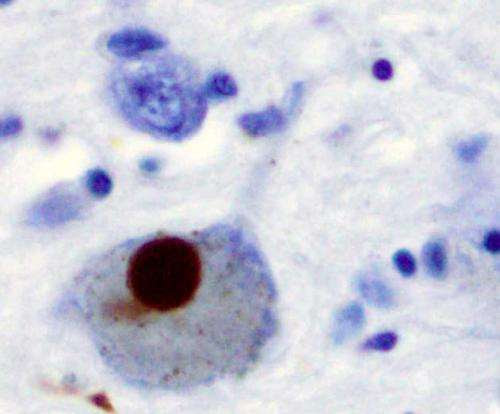by University of Cambridge

Researchers have uncovered a link between the structure of the protein alpha-synuclein and its likelihood to misfold and aggregate.
Alpha-synuclein aggregates are the hallmark of neurodegenerative disorders, such as Parkinson’s disease. Their findings, published today in Nature Communications, identify potential new therapeutic targets in the treatment of Parkinson’s disease.
The human brain contains a protein called alpha-synuclein (aSyn), which is found mainly at the tips of neurons in structures called pre-synaptic terminals. In Parkinson’s disease and some other neurodegenerative disorders, the aSyn protein becomes destabilised, misfolds and aggregates into insoluble fibrils, which are a hallmark of the disease. Currently we do not understand why aSyn misfolds or how to stop it doing so. This means that diseases like Parkinson’s, which affects one in 350 adults in the UK, remains incurable.
“We wanted to understand why the normally healthy, monomeric and soluble aSyn suddenly starts to misfold,” says Dr. Amberley Stephens, first co-author of the research paper, at the University of Cambridge Department of Chemical Engineering and Biotechnology.
“Understanding these initial steps in the misfolding pathway means we can identify new therapeutic targets to treat aSyn misfolding disorders. However, this is made very difficult because aSyn has no true structure but exists as lots of intermediate structures or conformations that are highly dynamic.”
To understand how to stop aSyn from aggregating in neurons, the researchers had to investigate what initial conformations monomeric aSyn forms when it is aggregation-prone compared to when it is non-aggregation prone and thus remains monomeric. The researchers purposefully made the aSyn aggregate faster by adding a known aggregation inducing ion, calcium, to investigate these tiny differences in the dynamic structure of the monomer.
The team used a collection of cutting-edge analytical techniques to investigate the various intramolecular interactions at play when aSyn was in either an aggregation-prone or non-aggregation prone state.
“In this study we used hydrogen-deuterium exchange mass spectrometry, a powerful and versatile biophysical technique that can give information on the structure and dynamics of proteins, such as aSyn. In simple terms, we are capturing the differences in the posture of the protein in different environments. Our collaborators at the University of Exeter have been working on instrument development, so that we are able to detect smaller and smaller differences between protein populations—this is particularly important for such a flexible protein like aSyn,” says Maria Zacharopoulou, first co-author of the research paper from the University of Cambridge Department of Chemical Engineering and Biotechnology.
They observed that one specific region called the N-terminus of aSyn, which is at the beginning of the protein sequence, becomes more exposed and the protein structurally opens up when the aggregation inducing ion, calcium, is added. Furthermore, the extent of the exposure correlated with the speed the aSyn aggregated at, while more closed structures did not aggregate.
By using hydrogen-deuterium exchange mass spectrometry the researchers could determine that modifications to the protein sequence, or the presence of hereditary mutations that cause early-onset Parkinson’s disease, lead to a change in the structures of the dynamic aSyn monomer. This study brings new insight into Parkinson’s disease at the very beginning of the process, when the transition from monomer to aggregate occurs.
The findings could lead to new therapeutic targets, as stabilising the closed structure of aSyn protein may prevent it from aggregating. The next steps will involve isolating specific aggregation-prone and non-aggregation prone structures from the pool of dynamic monomer structures to design therapeutics to stabilise or neutralise the aSyn monomer before it starts to misfold.
Explore further
Protein shows promise in treating Parkinson’s disease
More information: Amberley D. Stephens et al, Extent of N-terminus exposure of monomeric alpha-synuclein determines its aggregation propensity, Nature Communications (2020). DOI: 10.1038/s41467-020-16564-3
Journal information: Nature Communications
Provided by University of Cambridge

Leave a Reply